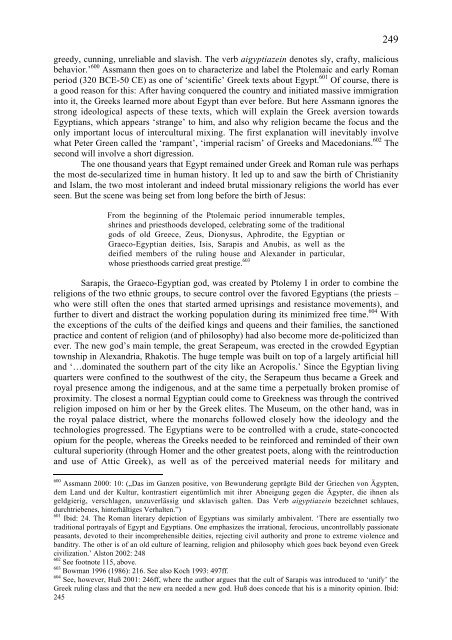Apartheid
Apartheid
Apartheid
Create successful ePaper yourself
Turn your PDF publications into a flip-book with our unique Google optimized e-Paper software.
249<br />
greedy, cunning, unreliable and slavish. The verb aigyptiazein denotes sly, crafty, malicious<br />
behavior.’ 600 Assmann then goes on to characterize and label the Ptolemaic and early Roman<br />
period (320 BCE-50 CE) as one of ‘scientific’ Greek texts about Egypt. 601 Of course, there is<br />
a good reason for this: After having conquered the country and initiated massive immigration<br />
into it, the Greeks learned more about Egypt than ever before. But here Assmann ignores the<br />
strong ideological aspects of these texts, which will explain the Greek aversion towards<br />
Egyptians, which appears ‘strange’ to him, and also why religion became the focus and the<br />
only important locus of intercultural mixing. The first explanation will inevitably involve<br />
what Peter Green called the ‘rampant’, ‘imperial racism’ of Greeks and Macedonians. 602 The<br />
second will involve a short digression.<br />
The one thousand years that Egypt remained under Greek and Roman rule was perhaps<br />
the most de-secularized time in human history. It led up to and saw the birth of Christianity<br />
and Islam, the two most intolerant and indeed brutal missionary religions the world has ever<br />
seen. But the scene was being set from long before the birth of Jesus:<br />
From the beginning of the Ptolemaic period innumerable temples,<br />
shrines and priesthoods developed, celebrating some of the traditional<br />
gods of old Greece, Zeus, Dionysus, Aphrodite, the Egyptian or<br />
Graeco-Egyptian deities, Isis, Sarapis and Anubis, as well as the<br />
deified members of the ruling house and Alexander in particular,<br />
whose priesthoods carried great prestige. 603<br />
Sarapis, the Graeco-Egyptian god, was created by Ptolemy I in order to combine the<br />
religions of the two ethnic groups, to secure control over the favored Egyptians (the priests –<br />
who were still often the ones that started armed uprisings and resistance movements), and<br />
further to divert and distract the working population during its minimized free time. 604 With<br />
the exceptions of the cults of the deified kings and queens and their families, the sanctioned<br />
practice and content of religion (and of philosophy) had also become more de-politicized than<br />
ever. The new god’s main temple, the great Serapeum, was erected in the crowded Egyptian<br />
township in Alexandria, Rhakotis. The huge temple was built on top of a largely artificial hill<br />
and ‘…dominated the southern part of the city like an Acropolis.’ Since the Egyptian living<br />
quarters were confined to the southwest of the city, the Serapeum thus became a Greek and<br />
royal presence among the indigenous, and at the same time a perpetually broken promise of<br />
proximity. The closest a normal Egyptian could come to Greekness was through the contrived<br />
religion imposed on him or her by the Greek elites. The Museum, on the other hand, was in<br />
the royal palace district, where the monarchs followed closely how the ideology and the<br />
technologies progressed. The Egyptians were to be controlled with a crude, state-concocted<br />
opium for the people, whereas the Greeks needed to be reinforced and reminded of their own<br />
cultural superiority (through Homer and the other greatest poets, along with the reintroduction<br />
and use of Attic Greek), as well as of the perceived material needs for military and<br />
600 Assmann 2000: 10: („Das im Ganzen positive, von Bewunderung geprägte Bild der Griechen von Ägypten,<br />
dem Land und der Kultur, kontrastiert eigentümlich mit ihrer Abneigung gegen die Ägypter, die ihnen als<br />
geldgierig, verschlagen, unzuverlässig und sklavisch galten. Das Verb aigyptiazein bezeichnet schlaues,<br />
durchtriebenes, hinterhältiges Verhalten.”)<br />
601 Ibid: 24. The Roman literary depiction of Egyptians was similarly ambivalent. ‘There are essentially two<br />
traditional portrayals of Egypt and Egyptians. One emphasizes the irrational, ferocious, uncontrollably passionate<br />
peasants, devoted to their incomprehensible deities, rejecting civil authority and prone to extreme violence and<br />
banditry. The other is of an old culture of learning, religion and philosophy which goes back beyond even Greek<br />
civilization.’ Alston 2002: 248<br />
602 See footnote 115, above.<br />
603 Bowman 1996 (1986): 216. See also Koch 1993: 497ff.<br />
604 See, however, Huß 2001: 246ff, where the author argues that the cult of Sarapis was introduced to ‘unify’ the<br />
Greek ruling class and that the new era needed a new god. Huß does concede that his is a minority opinion. Ibid:<br />
245

















